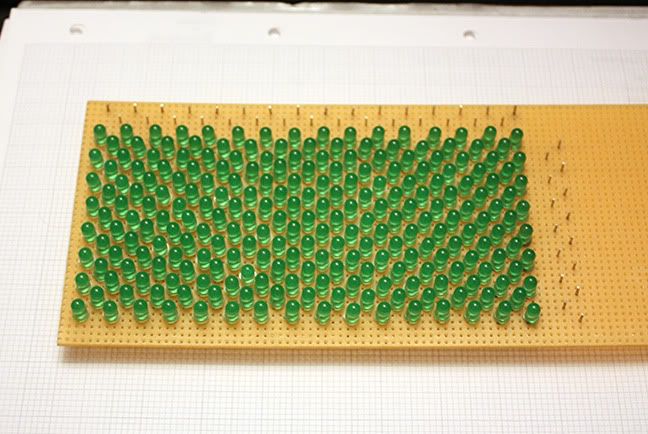I have this ongoing project (not really deserving of the name as it has taken 4 years so far) to make one of those Christmas light nets which can be programmed to display text/graphics. Rather than use a standard array, I thought it might be interesting to use an interleaved quincunx array, which in theory gives double the vertical and horizontal resolution. This is a prototype I made to play around with rather than having a huge wall sized thing.

Oh boy, that lot took some soldering!
When a board is heavily populated or reworked (say with the help of a hot air gun.....), you often find that the board curves. Two questions:
1) Why does it curve? Is this due to the copper side being unable to return to its original dimensions due to the introduction of added material within the copper plane while heated? Is there some change in the epoxy layer? It seems to happen when many components are (re-) soldered.
2) How do you prevent it? Would a brace/frame during the soldering prevent this effect from taking place?
.o:0|O|0:o.
Were you intending to make a new topic or something?
I think a board warps because the thermal expansion rate of materials on the board is different. When you only heat up one part of the board it'll warp in that area. That said, I haven't ever had problems with this and I've applied way too much heat to FR-4's before. Is your board particularly thin?
You can try using a pre-heater. Either a skillet or hot plate or one of the expensive dedicated PCB preheater units. It bakes the entire board at a nice temperature so that there's less thermal shock when you solder.
I just wanted a reasonable explanation to a question relating to a slight curve I noticed in the prototyping board above, which is barely noticeable in this case, but which I have seen many times when working on various boards to a greater extent. So, in answer to your first question:
not really. However, I have removed my post from the other thread to this one to avoid hijacking and irritating people. Then if people have any ideas they can comment.
My question was deeper, but not very. I am familiar with thermal expansion coefficients being different for different materials - bimetals use the principle to great effect. However, bimetals (unless they have peculiar properties like Nitinol) return to their former size and shape once allowed to cool down. The copper on that and on other boards should return to its former size and near lack of curvature, yet it often doesn't. Admittedly, the question barely applies to the board shown, but it reminded me of something I worked on recently.
.o:0|O|0:o.